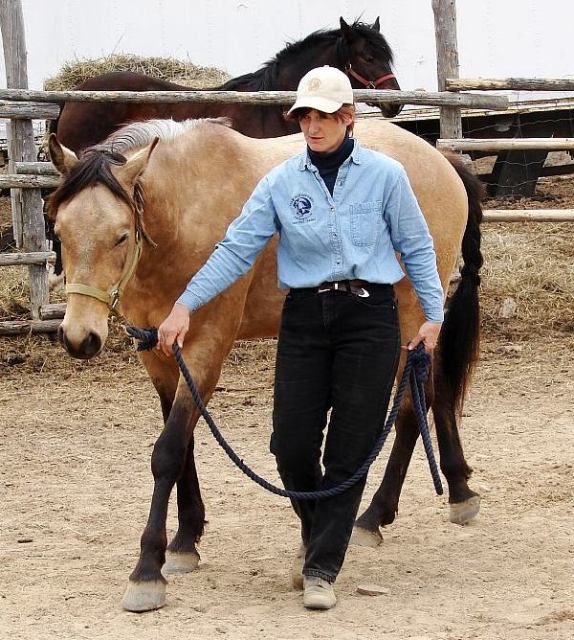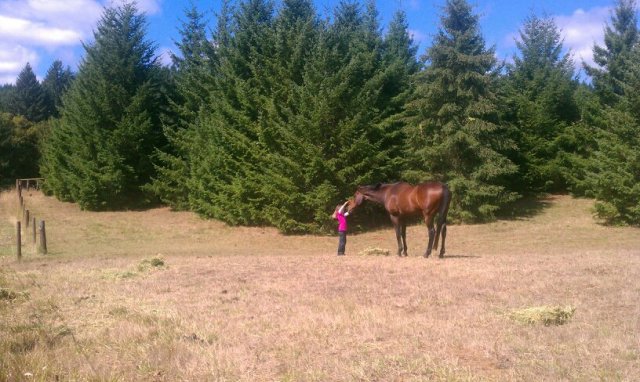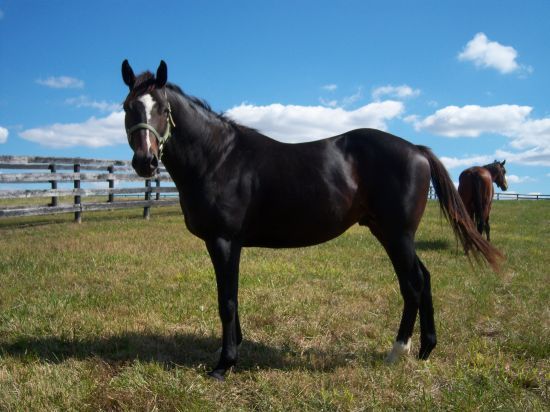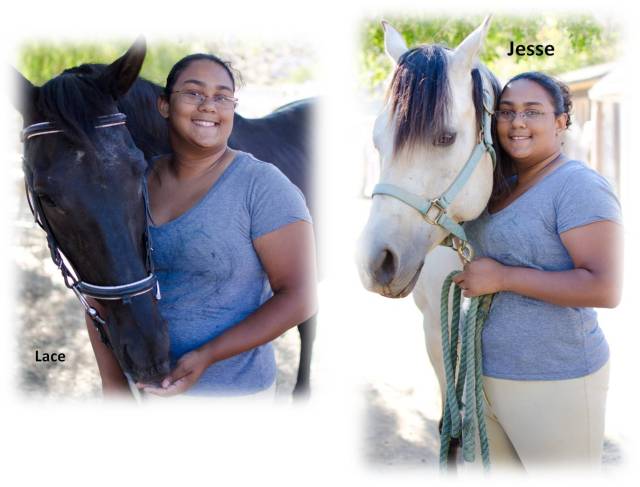QuestionI have a horse around 7 years old. I previously had a bad trainer who told me to use heavy bits, spurs, and to seesaw. Finally (after about 1 year) I realized I had only established having my horse dislike me:( We have a deeper connection now and I would like to progress. I would just like an idea of where to start him off. I plan to do english, jumping,maybe even some dressage to change things up. He pretty much knows only how to walk trot canter. I have not been using much contact for fear I will do him wrong again. I would like to establish a nice bend, collection, and later go on to bigger things. Any ideas of where to begin? When it gets nicer out Im hoping to trailer to a different barn for good lessons, but until then I would like to do something meaningful. Thank you( also I use a nice D ring on him now, he likes it much better:)
AnswerHi Kelly!
I'm so excited for you! The path that you are on now will be the most rewarding for you and your horse. Sometimes we have to hit some pretty big bumps in the road to really appreciate the new gifts that come our way!
A "D" ring is a good choice in bits. It is fair in the right hands and allows for very clear communication between horse and rider. Remember, any tool can become harsh and unfair in the wrong hands.
Ground work is the most important place to start in a horses education. How a horse is on the ground is a reflection of what they will be in the saddle. I like to say that we ride them from the ground and when we are riding we are leading them from their back. I'm pretty sure that some of the basics were missed in his kindergarten education. This is the main reason horses, and humans, have trouble, the horse is expected to go to college without ever having attended pre-school, kindergarten or 1-12 grades! Think of it in human terms, pretty difficult, but we expect it from the horse all the time. The wonderful thing is that horses are so forgiving! You will have dues to pay, but with your attitude and conviction, you will be able to make some huge changes. The other gift is the knowledge of what a bad "trainer" looks like. So many people that are just starting out don't know what to look for. Really they are just looking for help and advice and don't know the difference between good or bad. There are a lot of people that call themselves "trainer" that have very little good/quality horse knowledge and education themselves. I always want people to trust their instincts. It if FEELS wrong, it probably is!
Good horsemanship is about feel, timing and balance. Knowing how to make the right thing easy and the wrong thing difficult. These are not my words, they came from Ray Hunt, and Ray will tell you the words came from his friend Tom Dorrence. I am proud and happy to share with people who my teachers are. I know that someone has walked the path before me, really great horsemen that truly understand the horse. I have very little respect for people that claim original information or claim to have "come up" with training methods on their own. I know the first and foremost, the horse is our best teacher. The horse is the originator of all of the best "training" knowledge and as a student of the horse, watching and learning from true masters, we can carry on a very rich tradition. There are a lot of fakes out there Kelly. I'm glad you know how to listen to your horse and to keep searching for the good stuff! All of that being said, let get to it!
Ground Work!!! Find a round pen or a 60'corral that you can round off the corners in. Horses tend to get stuck in corners and we can't get the smoothness we are looking for with so many constant starts and stops. Begin at the beginning. I would re-start your horse just like a colt, knowing that valuable information has been skipped. The things that were done with quality will shine clearly as will the missed information. Start by hooking him on. Yielding his hind quarters, changing direction by leaving the hinds in one place and walking the fronts around the hinds, this is getting the fronts to come through. When he understands this and is solid about hooking on, that is to say his focus and attention are on you with softness and obedience, and you can as for hindquarters, frontquarters, change in direction, backing, full pass, all from the ground without a halter, then move on to your lass rope. A good lass rope is 60' long, a smaller diameter is better for a womans hands, make sure it is triple extra soft with a great basin honda or a brannaman honda. DO NOT USE a team roping rope. They can cut your horse like a saw. Go to King's Saddlery (the link in on my website) and ask for the Brannaman horse rope and honda. They will make sure you get the proper rope. With your lass rope around your horses throatlatch, build in another layer of ground work. Do all of the same things that your did with your horse free in the pen. With the lass rope you do not have control of the horses head and therefore cannot yard the horse around. Using the lass rope requires better feel on the part of the handler and more cooperation on the part of the horse. It is more pure and let you know when you are on the right track. I would make sure your horse can lead by the front feet, stop on the hind foot, packs the rope on his belly and flanks with relaxation and confidence. Also make sure HQ and FQ are good. When all of these things are working, move on to your rope halter and build on a third layer of HQ and FQ, back circles having the horse reach his outside front foot out and back until you have backed a full circle. This builds in amazing softness and control of the feet. Work on leading your horse by on the fence so he can pick you up from the fence. Not only is this convenient for mounting, it also shows you how much control you have over your horses feet and body and illustrates how well your communication is coming along. When all of these things are good, start exposing your horse to your flag, tarp and slicker (FTS). This will show you how confident your horse is or where his confidence is lacking. NEVER MAKE your horse stand still for this. If your horse cannot stand, allow him to move in a 10m circle around you. Keep him working at yielding the HQ, keep the feet moving in a meaningful way, don't allow the front end to lock up, you are also working on building in suppleness and relaxation here. Keep working at this until you horse can OFFER to stand relaxed on a loose lead. You will know when you have this good when you can get careless with your FTS and your horse remains RELAXED. Make sure he is comfortable with the FTS standing relaxed AND walking relaxed. When all of these things feel good to your and your horse it is time for mounted work. Again, you will start by building on another layer of HQ/FQ, deep bending, backing circles, riding with your flag, riding with your lass rope. You will see a level of suppleness that will really impress you as well as a real change in confidence in your horse.
I know there is a lot of information here. It will really help you to look at some of the following DVD's and I'll also give you several books to add to your equine library:
"Ground Work" DVD by Buck Brannaman
"Ground Work" Book By Buck Brannaman
"Back to the Beginning" DVD by Ray Hunt
"Turning Loose" DVD by Ray Hunt
"Think Harmony with Horses" Book by Ray Hunt
"True Unity" book by Tom Dorrence
"True Horsemanship thru Feel" book by Bill Dorrence
I would start with the Ground Work DVD and book by Buck Brannaman first. They are very straight forward and clear and will help you greatly with what I've tried to explain here. Then move on to the others. If at all possible, attend a clinic with Buck, Ricky Quinn or if Ray is still traveling this year, him. These guys travel the country, being very quiet, no big production, just helping people like you with their horses.
Be very careful when choosing someone to listen to. If you are willing to trailer out for lessons, please, please check into a clinic with one of my teachers. I know the quality you will receive. OOOppsss!!! I almost forgot, and shame on me WALTER ZETTL! He is a dressage master and spends part of the winter with Ray! The man is magic! Ride with these people. They are the real deal! You will become very picky, and a good thing too, when allowing someone the privilege of teaching you and your horse. Never allow a fake to influence you or your horse. Be an advocate for your horse and always insist on references. Ask who the "trainer" learned from, ask about their philosophy. How does it FEEL to be around them, how does your horse feel? If your instincts are telling you to run...do it! Your horse will thank you and so will I!
If I have used terms and concepts that you do not quite understand, please let me know and I will clarify! Enjoy this new journey, it is special! Keep me posted!
Smiles! Denise
If I have

 Arabian Mare
QuestionI have had a large dog coming onto my property
Arabian Mare
QuestionI have had a large dog coming onto my property
 trotting on the road
Question
road
hello. i am rohit from india. i ha
trotting on the road
Question
road
hello. i am rohit from india. i ha
 welsh 2yr old
QuestionHi there, was just reading a post about a lady
welsh 2yr old
QuestionHi there, was just reading a post about a lady
 Starting a terrified horse
Question
Ben
Hi. I have a 5 yr old tb gelding that I ha
Starting a terrified horse
Question
Ben
Hi. I have a 5 yr old tb gelding that I ha
 Thank you!!!
Question
Me & My Girls
Hi Rick,
I sent you
Thank you!!!
Question
Me & My Girls
Hi Rick,
I sent you